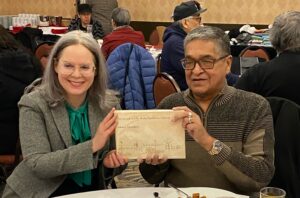
Ogichidaa Francis Kavanaugh of Grand Council Treaty #3 is presented with “The sacred scrolls of the southern Ojibway” by Karen Drake, Counsel at JFK Law LLP and member of the Wabigoon Lake Ojibway Nation.
At a recent 4-Directional Workshop for Grand Council Treaty #3’s Abinoojii Inakonigewin hosted on Treaty #1 territory, JFK Law LLP was pleased to present Ogichidaa Francis Kavanaugh with a first edition of the rare publication known as “The sacred scrolls of the Southern Ojibway”. Out of print for decades, this book was written in the early 1970’s by Canadian author Selwyn Dewdney and concerns a number of Anishinaabe[1] birch bark scrolls safeguarded by the late Ojibway Midewid[2] Elder James Red Sky Senior (Eshkwaykeeshik).
Known as wiigwaasabak in the Anishinaabe language, birch bark scrolls have long been fashioned from the outer layers of the paper birch tree, bound together with cedar or spruce roots, and inscribed with complex written and pictographic language using a stylus most-often crafted from wood or bone. Used to preserve and transmit important spiritual, cultural, and legal knowledge throughout Anishinaabe history, mide-wiigwaas like those preserved by Elder Red Sky are of special significance to the Midewiwin, or the traditional Medicine Society of the Anishinaabe Nation. One such scroll, for instance, is the 2.6-meter-long mide-wiigwaas known as “Red Sky’s Migration Chart”. Pictured and described in Dewdney’s book, this sacred artifact recounts the prophecy and historical voyage that brought the Anishinaabe people from their former home along the Atlantic coast and towards Nayaano-nibimaang Gichigaamin (the Great Lakes) where the voyage was prophesized to end “where the food grows on water”.[3]

Red Sky’s Migration Chart, with annotations, as reproduced from the wiigwaasabak of Elder James Red Sky Senior in “The sacred scrolls of the Southern Ojibway”
As important repositories of wisdom and knowledge as well as a written counterpart to oral histories, wiigwaasabak have long played a vital role in the preservation of traditional Anishinaabe ways of life. After Canada’s Indian Act made it illegal for First Nations people to practice their traditional languages, spiritualities, and cultures, many such scrolls were buried or hidden to preserve their knowledge for future generations. Related colonial attempts at assimilation including Canada’s system of Residential “Schools”, the “Sixties Scoop”, and the modern administration of Indigenous Child Welfare have taken much away from Anishinaabeg and other First Nations Peoples across the lands known as Canada. The falling into disuse, or relative loss of traditional practices for taking care of Anishinaabe children and families is but one aspect of these colonial harms that have resulted in extraordinary damage being visited upon Treaty #3 communities to this day.
A family man and long-time warrior on behalf of Anishinaabe children and families, Ogichidaa[4] Francis Kavanaugh has been instrumental in the development and substantiation of Abinoojii Inakonigewin, or the “Child Care Law” of Grand Council Treaty #3. During the Anishinaabe Nation in Treaty #3’s recent 4-Directional Workshop for Abinoojii Inakonigewin, JFK Law was pleased to present Grand Chief Kavanaugh with a copy of “The Sacred Scrolls”—a small token of our appreciation for this important cultural guardian and leader, as well as a fitting gift for one who has done so much to protect the future of Anishinaabe communities. Honoured in his fourth term as Ogichidaa, Grand Chief Kavanaugh is from the Sturgeon clan of Naotkamegwanning First Nation where he resides with his wife of 53+ years, Betty, along with his four children, eight grandchildren and one great grandchild.[5]
We at JFK Law look forward to continuing our meaningful and productive relationship with Ogichidaa Francis Kavanaugh and Grand Council Treaty #3 in the months and years to come and honour him for his important and ongoing contributions to the well-being and cultural resurgence of the Anishinaabe Nation, its peoples, and its communities. Chi’Miigwetch Ogichidaa!
_______________________________________________________________________
[1] The Ojibway, otherwise known as Ojibwe or Chippewa, are one ethnie (distinct group with own Creation story, language, culture, sacred teachings) that includes several Anishinaabe Nations [including the Anishinaabe Nation in Treaty 3] who have been resident on Turtle Island—the lands now known as North America—since time immemorial.
[2] Midewi are members of the Midewiwin, the traditional Medicine Society of the Anishinaabe Nation.
[3] The prophetic forecasting of “where the food grows on water” was fulfilled for the Anishinaabe by the Creator’s gift of manoomin, otherwise known as wild rice. One of the most vital traditional food sources of the Anishinaabe Nation, manoomin has supported Anishinaabe ways of life for hundreds of years but has been deeply impacted by activities under European colonization including resource extraction, excessive urban development, and other Treaty breaches resulting in environmental degradation.
[4] Though the English language is often insufficient for adequate translations of Anishinaabemowin, “Ogichidaa” refers to a traditional headman, leader, veteran, or warrior in the Anishinaabe Nation. The feminine counterpart of the masculine Ogichidaa is “Ogichidaakwe”. Ogichidaa and Ogichidaakwe are chosen to represent the Anishinaabe Nation in Treaty #3 through traditional selection processes. The tradition of “boundary warriors” or Ogichidaa was to keep the peace with neighbours but to establish permanency and security within the way of life for communities in Anishinaabe territory or Manito Aki. The term when applied to young people talks about the promise of leadership, vision, and keeping to Anishinaabe values and teachings by Treaty 3 youth.
[5] Grand Council of Treaty #3, “Our Nation” online, Grand Council Treaty #3: <https://gct3.ca/our-nation/>.
